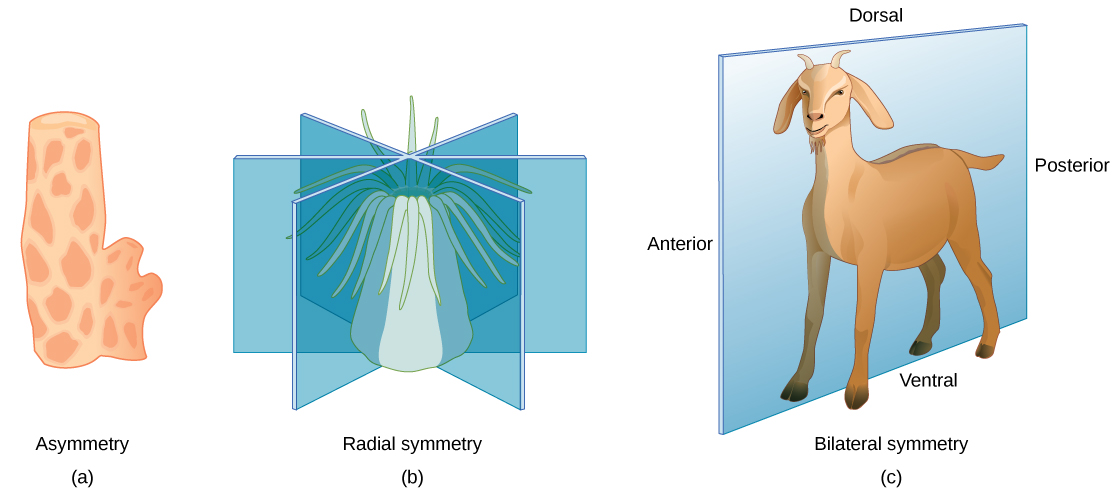| << Chapter < Page | Chapter >> Page > |
Animals may be asymmetrical, radial, or bilateral in form ( [link] ). Asymmetrical animals are animals with no pattern or symmetry; an example of an asymmetrical animal is a sponge ( [link] a ). An organism with radial symmetry ( [link] b ) has a longitudinal (up-and-down) orientation: Any plane cut along this up–down axis produces roughly mirror-image halves. An example of an organism with radial symmetry is a sea anemone.

Bilateral symmetry is illustrated in [link] c using a goat. The goat also has upper and lower sides to it, but they are not symmetrical. A vertical plane cut from front to back separates the animal into roughly mirror-image right and left sides. Animals with bilateral symmetry also have a “head” and “tail” (anterior versus posterior) and a back and underside (dorsal versus ventral).
The division of an animal into repeating body parts is called segmentation . You can clearly see segmentation in earthworms and millipeds, but in some insects and chordates the subdivisions are not as obvious. What are the advantages of a segmented body? Segmentation allows for greater flexibility and mobility. The repeating body parts allows for specialization of specific body parts, such as the development of legs, arm and wings.
Nearly all animal species undergo a layering of early tissues during embryonic development. These layers are called germ layers . Each layer develops into a specific set of tissues and organs. Animals develop either two or three embryonic germ layers ( [link] ). The animals that display radial symmetry develop two germ layers, an inner layer (endoderm) and an outer layer (ectoderm). These animals are called diploblasts. Animals with bilateral symmetry develop three germ layers: an inner layer (endoderm), an outer layer (ectoderm), and a middle layer (mesoderm). Animals with three germ layers are called triploblasts.

In triploblasts, the three germ layers develop in all the parts of an adult animal. The endoderm gives rise to the innermost lining of internal organs, such as those in the digestive tract, the liver, the pancreas and the lining of the lungs. The majority of organs and tissues in an adult animal such as the kidney, heart, muscles, blood vessels, bones and the dermis (inner layer of skin) develop from the mesoderm . Lastly, the ectoderm develops into the outermost layer of skin (epidermis), the lens and cornea of the eye, and the nervous system (brain and nerves).

Notification Switch
Would you like to follow the 'Principles of biology' conversation and receive update notifications?